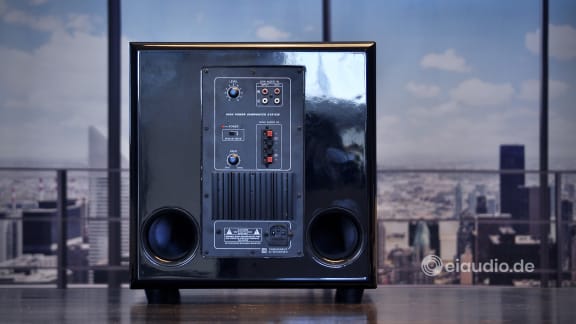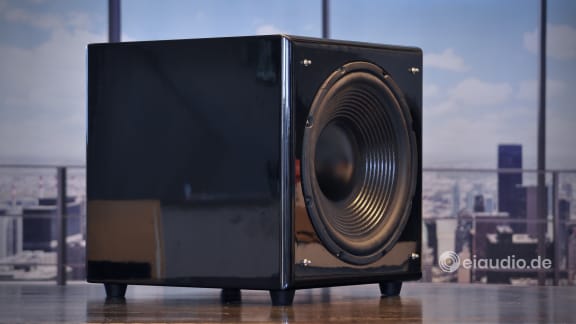Dragon Audio Dream 2 Sub
Published: 29/09/2022
Manufacturing date: 2012
Author: Karsten Hein
Category: Gear & Review
Tag(s): Subwoofers
Born in the early 1970s, I grew up listening to music on mono and stereo Mid-Fi systems. Our Grundig TV was still black and white with an oval wide-band driver mounted to the right of the tube. And while I was looking forward to my father purchasing a colour TV, improvements in sound were the last thing on my mind. We listened to records via a Dual turntable and simple Grundig RF240 system, on which one speaker could be detached for improved stereo effect. This also had a built-in radio tuner, but I much preferred the warm and fuzzy midrange-focused sound of our Saba tube radio. It never once occurred to me that we needed more bass-slam or that our movies were lacking in cinematic effects in any way. Being visually and acoustically sensitive myself, I found that a great number of movies showed more than enough realism, even when shown in black-and-white and with mono sound.
The first HiFi systems I purchased and built for myself during the 1980s and 90s were simple stereo setups with records, cassette tapes, and CD player as source. In those days, it was common to tweak the sound with multi-band equalisers which usually involved increasing the bass and treble response of the speakers. The resulting sound curve was either V-shaped or similar to a bathtub. In 1987, Bose introduced the Acoustimass series which I heard play at a friend’s house. This featured one separate bass unit and some smallish-looking satellite speakers. The system had been ridiculously expensive, and my friend’s family was very pleased with the result, but I could not hear the benefit of this design and felt that this had been engineered to improve the visual appearance rather than the sound stage.
I continued to explore the potential of stereo listening, even when the cost of multi-channel systems using subwoofers began to fall. Whenever I did hear multi-channel systems play, I felt that something was not quite right in the integration of the subwoofer, unless they were for the purpose of listening to music score or for the enhancement of sound effects. I was surprised to find that this was even true for some professional setups using large Bowers & Wilkins loudspeakers with a front-firing subwoofer. Perhaps it was due to these early and continuous experiences that I did not consider delving into the subject more deeply, until I purchased a pair of Shure 701 Pro Master PA loudspeakers and later discovered that they had been designed as mere tops to work with a subwoofer. This meant that I suddenly had an acoustic gap to fill and that a subwoofer would be the only way to fill it.
Remembering the performance of the less-than-impressive B&W setup, I decided that I would make a list of requirements and then simply choose the subwoofer that fit my list at the most affordable price point. It needed to be actively powered and fitted with a low-level cinch/RCA input. I was also looking for a vented front-firing design with volume level control, cut-off frequency adjustment, and simple 180° phase correction. And I finally found all these features combined from a vendor in Darmstadt who had established a reputation as a distributor for the Chinese brand 'Dragon Audio'. Founded in Shenzhen back in 2004, Dragon Audio had grown to become a major OEM producer of audio gear with over 1,400 staff working in their 14 factories in China.
Their ‘Dream 2 Sub’ model came in glossy piano black lacquer and housed a front-firing 30cm woofer with soft a suspension. Two large rear ports served to minimise air noises but did demand a greater distance to the walls of the listening room, as the wall distance should be at least twice that of the total port diameter. At around 40 cubic centimetres, the outer dimensions of the Dream 2 were still considered to be about average in the world of subs. Looking at the Dream 2, one could see that the lacquer could have been applied more evenly and thicker and that the built-in amplifier could have been given a sturdier base plate and cooling socket, perhaps. However, when I factored in the low price, I was still impressed with what Dragon Audio had visually achieved. When it came to sound and overall performance, I was not yet sure what to expect.
Turning the Dream 2 Sub on for the first time, I heard a mild humming noise coming from the woofer. This noise remained for as long as the integrated amplifier was in operating mode. The noise was just bearable enough for me not to follow the impulse of returning the woofer to the vendor. Another issue I noticed was that the internal amplifier would switch into standby on quiet movie scenes. While this effect did not usually occur during music playback, it could be bothersome when watching movies late at night, especially because there was an audible popping sound on each event. I also noticed that the smallish heat sink could get quite hot during longer listening sessions. As I was otherwise happy with the subwoofer, I decided to ask my trusted service technician to have a look inside with me.
As we opened the Dream 2 Sub by taking out the amplifier board, I was pleased to find a closed wood cabinet around the amplifier that would protect it from vibration. The cabinet itself was of sturdy build quality. I was, however, a little disappointed with the amplifier itself. While it featured a conventional linear transformer, this was relatively small for the task, at around 30 watts, and placed too close to the main circuit board. The audible 50Hz humming was a natural result of this close placement and would be difficult to resolve. In addition to this, the power supply capacitors were also relatively small for the job of eliminating noise. The Dream 2 Sub’s high sensitivity of around 90 dB at 1 watt meant that the amplifier’s power would still be sufficient to enjoy music at household volumes. The sound output was generally acceptable, although we could detect a slight mismatch between the upper and the lower sine waves, especially when the unit was driven at low input volumes.
While the issues detected were not necessarily a deal breaker when purchasing an entry-level sub, the Deam 2 was just barely sophisticated enough to be the protagonist in my planned subwoofer placement explorations. I could only marvel at DA's ability to employ 1,400 factory workers based on this relatively low level of quality and performance.
Specifications
- Model: Dream 2 Sub
- Type: active Subwoofer
- Principle: front-firing, dual rear-ported
- Driver: dynamic, 12-inch
- Frequency range: 20-200 Hz
- Power handling: 100 watts RMS
- Phase adjustment: 180° inversion
- Volume control: full range on input
- Low-level input: cinch, stereo
- High-level input: speaker wire, stereo
- Amplification type: class A/B
- Sensitivity: >90 dB
- Features: automatic standby
- Finish: piano black, removable cloth grill
- Dimensions: (H) 370mm, (W) 370mm, (D) 400mm
- Weight: 11 kg
- Year: 2012






